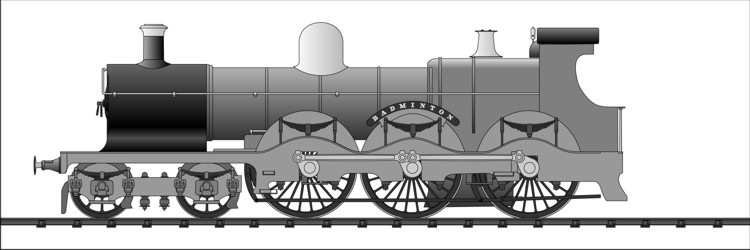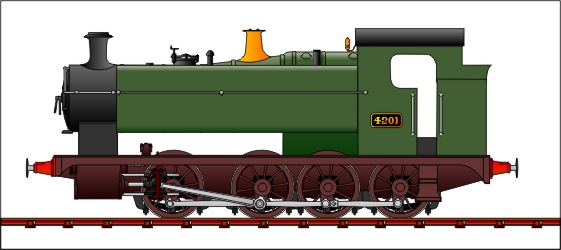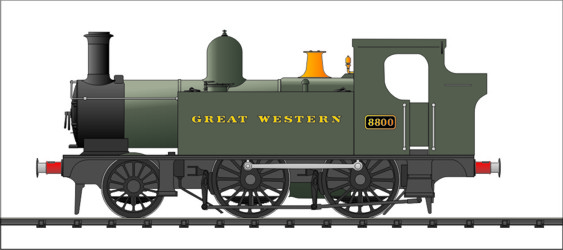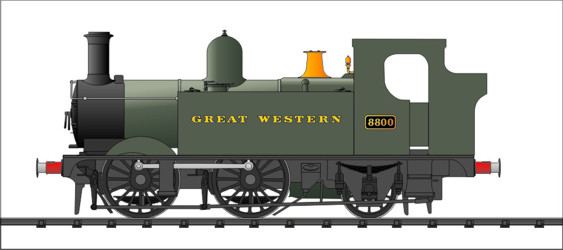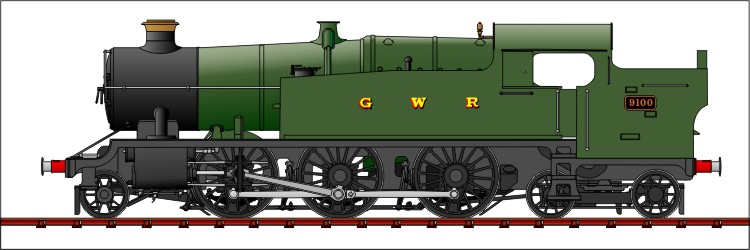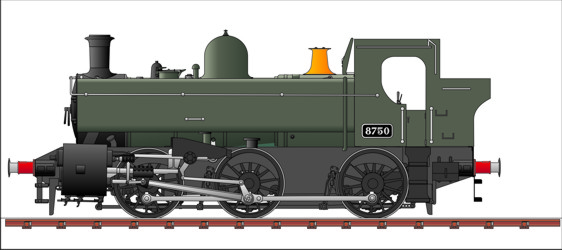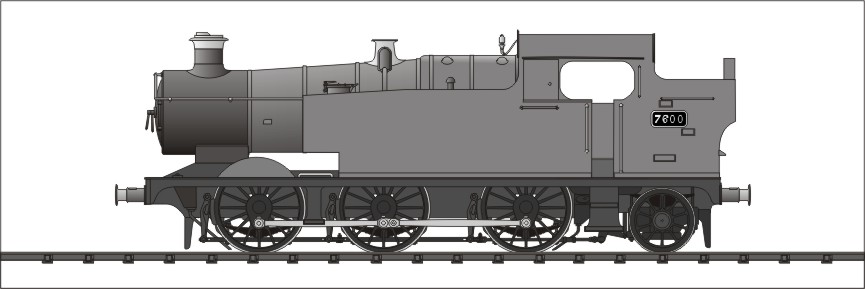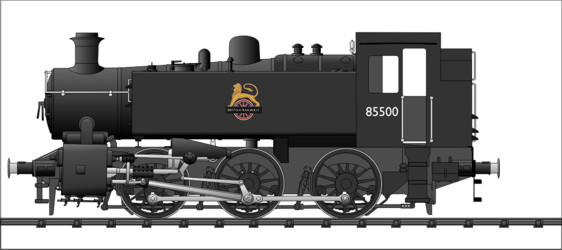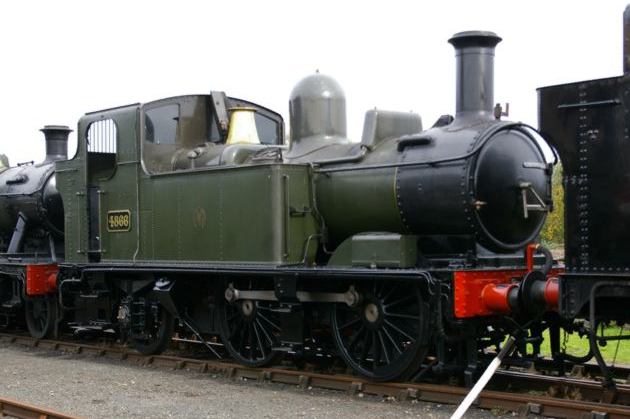Fictitious Locomotives
I created drawings of all the Churchward and later classes for my book, "An Introduction to Great Western Locomotive Development" As a result I have a large library of pieces from the GWR "kit of parts" and there is an inevitable temptation to reassemble them in a different form. It is a temptation I have found impossible to resist, especially in "What If" topics on forums. So here are a few of my fictitious locomotives, the hopefully practical, the impractical, and the plain ridiculous. Some of these are loosely based on real proposals, but one should always remember that the drawing offices sometimes drew up weight diagrams of proposed locomotives in order to demonstrate why they would not have worked.
A Dean 4-6-0
This is definitely impractical, bordering on the ridiculous. A sketch to suggest that a Dean style large wheeled 4-6-0 would not have been a success. The low slung boiler requires a grate between the wheels, so the boiler is over-long, and the whole locomotive is badly proportioned. The boiler is completely imaginary, based on the Badmintons as built, and the rest of the locomotive is also mainly Badminton.
A Churchward 0-8-0PT
This was a real GWR proposal, and according to RCTS it was drawn up around 1905. Its drawn with just 12 tons weight on each of the driving wheels, and a wheelbase of only 15ft 3in, fractionally shorter than that of a large pannier tank like the 2721 class. It would have had very wide route availability and power class B or C. Note the very high pitched boiler needed to get the ash pan clear of the driving wheels - the boiler is six inches higher than the 4400s. The original drawing has very little detail, and it seems likely the proposal was abandoned at an early stage. I've drawn an approximation of 1905 livery with no GWR branding on the tank as was typical at that time. I've given it the number 4201 as it would have predated the real 4200 class.
The Great Bear reboilered
The Great Bear with a combustion chamber boiler, somewhat patterned after the Stanier pacifics, and also treated to external axleboxes on the trailing wheels.
A Little Bear!
If Churchward has favoured atlantics, and if the Great Bear had been a success, this is a 4-4-2 based on No 40s chassis with a shortened version of the Great Bear's boiler. In practice it would probably have had excess weight on the driving wheels and been rather slippery.
A Greater Bear!
An equal and opposite error! Conventional wisdom is that the Great Bear's boiler, with 23ft long tubes, was simply too long in the barrel. Its certainly longer than even giant US Mallets. However there is an exception. German practice never favoured combustion chambers, and the German DRG05 4-6-4 that held the steam speed record with 200km/h on essentially level track also had 23ft tubes. It also, of course, had a far bigger firebox than the Bear. A few sums, however, suggested that a bigger firebox could be fitted to a 4-6-4 version of the Bear to give very similar proportions to the German locomotive. So here you are.
And now for something completely different...
One of my more ludicrous fantasies. Some of the early 42xx had their
bunkers extended twice for more water capacity, the second time when
they were converted into 7200 2-8-2Ts. Supposing if instead they were
simply coupled with small tenders as water tanks? This is a short
19thC tender, with the coal space and hand brake gear removed and
presumably an enlarged water tank. The assumption is that the water
pick up gear is now steam operated remotely.
A severe flaw in
the concept is the water level, since the tender will be overflowing
before the side tanks are half full. Perhaps it needs a very tall air
vent? Due to the use of the short wheelbase tender the combination
should still be able to be turned on a 55ft turntable. Great Western
on both tender and locomotive looked odd, so I moved the number plate
to the middle of the tank, where it had been on some earlier classes.
Four Coupled Tank Engines in the Collett Style
A four coupled variation on the 5400 pannier tank. I'm a bit unsure about weight distribution. Its using the Std 21 boiler and most other components from the 54s. The leading wheel is large prairie sized.
The 2-4-0 pannier tank redrawn with side tanks, and looking very like the Metro tanks in their final guise. The weight distribution might be a little better than the pannier tank.
The modified 5400 again, this time in 0-4-2 guise. Its a larger and more powerful engine than the 4800/1400, but I think you'd be hard put to tell the difference at a glance.
Large Suburban Tank Engines
A really big passenger tank. A tank engine based on the Halls or Granges would be well over weight, but the lighter and shorter Manor boiler ought to bring this 4-6-2 tank within red route restrictions. The chassis is basically Manor, with tanks and bunker styles after the large prairies and 2-8-0Ts.
I don't think the standard kit of parts makes up into a useful 2-6-4 tank. This one has a new boiler, which is basically a Castle firebox and a Castle barrel shortened to Std 4 length. The Std 4 boiler is arguably a bit short on grate area, but this is probably the equal and opposite error. Its assumed that the side tanks are narrow and light, even narrower than those on the 2-8-0T, and the majority of the water capacity is in a tank under the coal space. Even so I have doubts about the weight limits. The rear bogie is also Castle. This drawing will get some more tidying up some time. With the same cylinders as a 3150 it wouldn't be any more powerful, but would have a good deal more steaming capacity if there were a use for that.
What shall we do with...
In the 1930s the GWR had a number of new 5205 class 2-8-0T and no obvious work for them. As we know they were converted into the 7200 class 2-8-2T. But what else might have been done with them?
Apparently at one stage Swindon considered rebuilding some of the 4200 class as tender engines with a Std 1 boiler, presumably as an alternative to building all new 2800s. This is my interpretation of the concept.
Whereas this drawing is based on an original 1941 GWR drawing, which I didn't get to see until after drawing the one above. The biggest difference between the two is that the Swindon drawing office drew a very high pitched boiler, which gave room for the firebox to be over the third pair of driving wheels, rather than behind, as I drew it. They also raised the running plate to the level of the raised section over the cylinders to avoid the use of wheel splashers.
Another 4200 rebuild, this imagines the locomotives rebuilt as small wheeled moguls. The adhesion factor would probably be distinctly unfavourable, with as much tractive effort as a Castle and rather less weight on the driving wheels. As the GWR was already converting 4300s to 4-6-0s at the time when there were new 4200s in store, its hard to see this would be a useful concept.
This nearly happened...
This isn't as much a flight of fancy as some of the others. Ken Cook
records that the GWR Running Department asked Collett for another
batch of 4700 2-8-0s, but Collett eventually elected to build more
Castles instead, as they would be similarly capable on fast freight
and better for relief passenger services.
If Collett had elected
to build more 47s they might well have looked like this. The frames
are 6 inches longer at the back to make room for a good sized (by GWR
standards at least!) side window cab, fire iron tunnel, and the
suspension compensation has been removed. Other than that few changes
seem likely, but I've also included screw reverse, which was designed
but never fitted to the original class members in the 1950s.
I'm calling this the Edward VII Class. RCTS tells us that Lot 137 of Bulldogs was originally planned to have the larger Standard 4 boiler, but in the event they were given secondhand Standard 2 boilers, and the Standard 4s were allocated elsewhere. So this is an imagining of the Standard 4 fitment as on the Cities applied to the Bulldog chassis. The boiler is pitched a little lower than on the Cities, and the cab a little higher than the standard Bulldog, but otherwise its all standard. 3361 Edward VII was the first of Lot 137, which was mostly named after politicians.
A Dean Goods Replacement?
This is intended to be a very lightweight 2-6-0 to replace the Dean Goods on routes that were barred to the 2251s. Its a tender version of the 4575 small prairies, and is towing a Collett era version of the short 2,500 gallon tenders built at the end of the 19thC. The concept is that it would have unrestricted route availability and be able to be turned on 45ft turntables.
In the event BR imposed BR Std 2 2-6-0s on the WR, which were notoriously unable to equal the Dean Goods at running the services until the draughting was worked on by Sam Ell at Swindon.
The ROD Class with a GWR boiler
RCTS records that at one stage, apparently under Hawksworth, consideration was given to reboilering the ROD class 2-8-0s with Standard 1 boilers. One presumes that at this sort of date some of the original boilers, which had been rebuilt by the GWR with copper fireboxes, were coming to the end of their lives. The conversion isn't altogether straightforward, and the back end of the smokebox looks rather cramped in my sketch. It may not be practical.
Outside Cylinders and Valve Gear
These are all variations on the 15xx chassis.
If it were decided to replace the 5700 fleet with outside cylinder 0-6-0s then this sketch shows the P class boiler on a longer wheelbase chassis with 1500 valve gear. Route availability should be appreciably wider than the 1500s.

A 2-6-0 based on the 1500 chassis and valve gear. Heavier than a 2251, but with the same boiler, the Std 10. It would probably be little more capable than the 2251 and less powerful than the 43s, so there's perhaps not much to say for it.

This flight of fancy is also fundamentally based on the 1500 chassis, but is a little longer than the one above in order to feature a standard 4 boiler. It would be rather heavy and limited in function, but perhaps not unattractive. The short wheelbase might make it something of a rough rider, and maybe it would be better with the trailing wheel moved backwards. It could be regarded as a modern equivalent to the Aberdares I suppose. A standard 2 boiler would possibly knock it down a weight class at the price of less steaming capacity.
It followed a logical process. Honest!
There was a logical sequence of thought behind this bizarre confection! A imaginary locomotives forum discussion proposed a 2-6-4 tender engine with a Manor boiler, and I had a bit of a play, but couldn't get anything that looked practical. Within the general Swindon narrow firebox outline a pair of trailing wheels looks more practical to me. I started sketching what might have been a sort of small 4700, but it didn't seem to have a role against existing classes and the 5ft8 wheels were problematic for space under the Manor boiler. Then a discussion on a different forum about the perfect preserved line locomotive came to mind. So I thought. OK, what about a Manor boiler and mainly 4575 components for a sort of small 4200. Sketching it quickly though it looked very ill proportioned with either a large rear overhang or an excessive long fixed wheelbase. A 2-8-2T still had a rather small bunker, and good water and coal capacity is important on some of the preserved lines, so that didn't seem too valid either. So at that point I sketched out this, which is still pretty oddly proportioned, but makes a kind of weird sense. Manor boiler with extended smokebox, Manor front bogie at the rear, most of the rest modified 4573. An uprated version could have Manor cylinders for greater power, but clearance problems on some lines. It would probably have good route availability - GWR blue restriction ought to be possible with appropriate sizing of the side tanks - and a decent amount of adhesion. But I still fear its rather ludicrous!
Baby Freight Haulers for axle load restricted routes
This was suggested or at least inspired by someone on the RMweb forum. Its a small 2-8-0T based on the 44xx. It has 4'1 driving wheels. The boiler is a standard 3. One of the Std 2 family, its basically a standard 2 with a shorter barrel, or could be held to be a Std 10 with a longer firebox. The wheelbase is just over 16 feet, so given the extra sideplay in the rear wheels of its larger sister it should be capable of hauling a reasonable load over fairly lightly laid and curving lines.
Also I think inpired from RMweb, this 4'1 wheel 2-10-0 is based around the Manor using the Manor boiler. The axle loading ought to be rather light. Maybe it would have been allowed to haul long freight trains across the Crumlin viaduct?
Churchward Era Mixed Traffic 4-6-0s
As is well known, Churchward's original standard scheme included a 5'8in wheel 4-6-0, but one was never built until the Grange class in the late 1930s. But what if?
This one imagines that the mixed traffic 4-6-0 was developed alongside the Saints, and this prototype was built about 1906/7, with a short cone boiler, no superheat and various other early features. The footplate is the same height as a Grange, but instead of the raised section over the cylinders there's an arrangement similar to the Churchward 2-8-0Ts. The three figure number is in line with other Churchward prototypes. Churchward's locomotive names were more varied and imaginative than his successors, and he was a keen fisherman, so Brown Trout seemed appropriate. I couldn't think of a UK freshwater fish starting with A.
On the other hand this sketch imagines a locomotive designed post war alongside the 47xx 2-8-0, which it shares a number of features with, notably a slightly higher footplate than the sketch above. Its easy to imagine a locomotive on these lines being built instead of later lots of 53xx and 63xx 2-6-0s, and it would probably also have precluded the Hall class.
And finally this last flight of fancy on the theme imagines Collett following the same principle as Star -> Castle, lengthening the chassis slightly and fitting a Castle boiler. The result would be something approaching the capabilities of the Hawksworth County Class and would surely have been a fine performer on fast vacuum freight and heavy passenger trains.
Welsh Passenger Locomotive
The Welsh lines which had 0-6-2Ts typically had passenger classes
with wheels over the 5' mark as well as freight/mineral classes with
wheels sized under 4'8. In the event these duties were mostly taken
over by 56xx and 57xx, but here I'm imagining a passenger 0-6-2T
based on the 2251, with the same 5'2 wheels. Much lower powered than
the 56xx it would have only managed shorter trains, but on the other
hand the 56s were prone to giving the leading carriages of their
trains quite a shaking, and this ought to have provided a more
civilised ride.
The unusual side tanks were mandated by the need
to give reasonable access over the footplate to the motion, and to
keep the weight somewhat towards the rear of the locomotive. Pannier
tanks would probably have left it too heavy at the front. There are
two precedents for a tank cut away at the bottom like this - the 1101
0-4-0Ts and the 97xx condensing pannier tanks.
Four Cylinder Variations
These are all interpretations of GWR drawing office projects that were never built.
This is the post war Churchward enlargement of a Star with a Standard 7 boiler. To my mind this could be considered as an early iteration of what became the Castle Class. As far as I can tell it could be a straight tracing of a Star chassis and cab with the larger boiler (which is slightly different to a Std 7 as built a year later) drawn in with the front tube plate in the same place as the standard one. There's no change to the cab at all, so the enginemen have a foot less footroom (but at least a bit more than the Bear).
Apparently in 1926 Hawksworth and Stanier worked up a proposal for a 4 cylinder compound based on the Castle, and took it to Collett, who spent about 5 minutes considering it before chucking it out! What exists is a basic weights diagram which has been reproduced in RCTS and elsewhere and which gives cylinder positions. So I've worked this up from the weight diagram.
Some points to note: RCTS states that the bogie centre was moved
forward 1'10" and the wheelbase increased to 8' 0". As I read the
weight diagram the leading bogie wheel has moved forward 16 inches
and the trailing bogie 4 in, so this is what I've drawn. It has a
plate framed bogie, something Hawksworth was to bring into existence
with the Modified Hall some 15 years later.
RCTS states the
boiler pitch was increased by 1.5in, which I've followed. The outside
cylinders are inclined slightly, and according to RCTS so were the
inside ones, which don't seem to be drawn on the diagram. My
interpretation is that the valve rods are horizontal, not inclined.
Reminiscent of how Holcroft suggested to Gresley he do the same thing
with his conjugated gear. This makes me think they were planning to
use straight rockers for the valve gear, although RCTS presumes
rocking shafts would have been necessary. I think the cylinder
position means there's room for rocking levers behind the cylinders,
which is as well because there isn't room on the inside in front of
them. The outside connecting rods appear to be standard 8'10.5 as on
Saints and Granges.
And the rocker position got me thinking... To my knowledge no-one
definitively knows why the Stars and successors have inside
Walschaerts valve gear, although there are plenty of theories. One
factor, however may be that I don't think there's any room for
rockers behind the Star cylinders, in which case the choices for
outside valve gear would be either to accept valve timing issues
caused by valve rod expansion, or else have 4 sets of gear, and if
you're going to have 4 sets of gear you may as well just have two
sets inside and rockers. So I suspect that after the scissors gear
was abandoned outside walschaerts was impossible without a complete
redesign.
However... On the Stanier/Hawksworth compound there is
room for rockers behind the cylinders, so its something they could
have considered. The running plate on the weight diagram clearly
doesn't give enough room for outside valve gear, so that wasn't in
the proposal, but just supposing... The GWR wasn't utterly opposed to
outside Walschaerts if necessary: its featured on both the Steam
railcars and the VOR 2-6-2Ts, even though there would have been ample
room for outside Stephensons on the VOR locomotives, and indeed their
Davies and Metcalf designed precursors had that arrangement. Outside
Walschaerts was also featured on some of the sketches for what became
the 4-6-0 Counties and of course the 15xx 24 hour shunters, so I have
drawn my own interpretation.
What I get is something like this. Not I submit, an aesthetic delight! As far as possible its the components from the inside Walschaerts transferred to outside, but there are changes forced by the need to clear the driving wheels. There are clearly all sorts of options for how they might have treated the need for the expansion link to clear the footplate. I've chosen to raise the footplate all the way along in a sort of exaggeration of the Manor/Grange treatment. An alternative might have been just a box over the expansion link area itself. I wanted to avoid having too many steps in the footplate and too much of an LNER look about the line.
Ugliest of Ducklings?
This is a "what if British Railways had built a standard class based on the 1500?" A domed version of the Std 10 boiler with pop safety valves and an LMS type bunker. The 1500 is rarely accused of being especially pretty, but I suggest that its Emma Watson alongside this imagined beast. As soon as that bunker replaced the GWR one in my graphics application the looks went out of the window.

